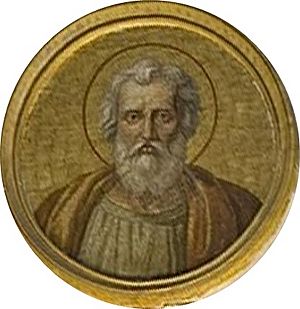Antipope Felix II facts for kids
Quick facts for kids Felix II |
|
|---|---|
 |
|
| Papacy began | 355 |
| Papacy ended | 365 |
| Predecessor | Novatian |
| Successor | Ursicinus |
| Opposed to | Pope Liberius |
| Personal details | |
| Born | about 287 Rome |
| Died | 22 November 365 (aged 78) Porto, Rome, Roman Empire |
| Denomination | Arian Christianity |
| Sainthood | |
| Feast day | 29 July |
| Venerated in | Catholicism |
Antipope Felix (who died on November 22, 365) was a Roman church official called an archdeacon in the 300s. He became an antipope in 355. An antipope is someone who claims to be the pope but is not officially recognized by the Church.
Felix became antipope after Emperor Constantius II sent the real pope, Liberius, away. Felix ruled as antipope until 365. The people of Rome did not want Felix as their leader. So, the Emperor tried to make Felix and Liberius rule together. But Felix was later forced to leave. People did not like him much when he was alive. However, his memory became more popular later on.
Felix was a Roman antipope who had to leave Rome. He moved to a place called Porto, where he died in 365 AD. Later, people got Felix confused with a Roman saint who had the same name. Because of this mix-up, Felix was added to lists of popes as Felix II. This mistake caused later popes named Felix to have the wrong numbers. Even Antipope Felix V was affected. The true story of Felix's time as antipope was forgotten. He was seen as a saint in local Roman history.
Felix's Story
In May 357 AD, the people of Rome were still loyal to Pope Liberius. They asked Emperor Constantius, who was visiting Rome, to bring Liberius back. The Emperor planned for Felix and Liberius to rule together. But when Liberius returned, Felix had to leave Rome and go to Porto. He tried to come back to Rome but failed. He died on November 22, 365 AD.
The Mix-Up with Saint Felix
This Felix was later confused with a Roman saint also named Felix. Because of this, he was mistakenly put on lists of popes as Felix II. This meant that later popes with the same name, like Pope Felix III and Pope Felix IV, were given the wrong numbers. The antipope Antipope Felix V also got the wrong number because of this.
The Catholic Encyclopedia (from 1909) called this confusion a "distortion of the true facts." They thought it happened because an old book, the Liber Pontificalis, said that Felix built a church. This church was on the Via Aurelia, where the Roman saint Felix was buried. However, newer information suggests that we only know the saint Felix's name and that he was a martyr. He was buried in a cemetery on the Via Portuensis.
Feast Day Confusion
The Catholic Encyclopedia noted that "the real story of the antipope was lost." He became known as a saint in Roman history. Because of this, he appeared in the Roman Martyrology (a list of saints) on July 29.
For a long time, the Roman Martyrology described Felix II as a pope and martyr. It said he was sent away by an emperor for defending his faith. It claimed he died a glorious death. However, this entry was based on later stories that mixed up Felix and Liberius. More recent versions of the Roman Martyrology have corrected this mistake. They now simply mention Saint Felix, a martyr, buried on the Via Portuensis.
The feast day for the Roman martyr Felix is July 29. The antipope Felix died on November 22. His death was not like a martyr's. It happened during a time of peace for the Church.
The Roman Missal (a book used for Mass) also used to identify the Saint Felix of July 29 with the antipope. This mistake was removed in later editions of the Missal. Some Catholic writers explain this by saying that the antipope Felix did refuse to accept Arianism (a different Christian belief). This is why his feast day was kept on July 29 in the past.
See also
 In Spanish: Félix II (antipapa) para niños
In Spanish: Félix II (antipapa) para niños
- Papal selection before 1059

